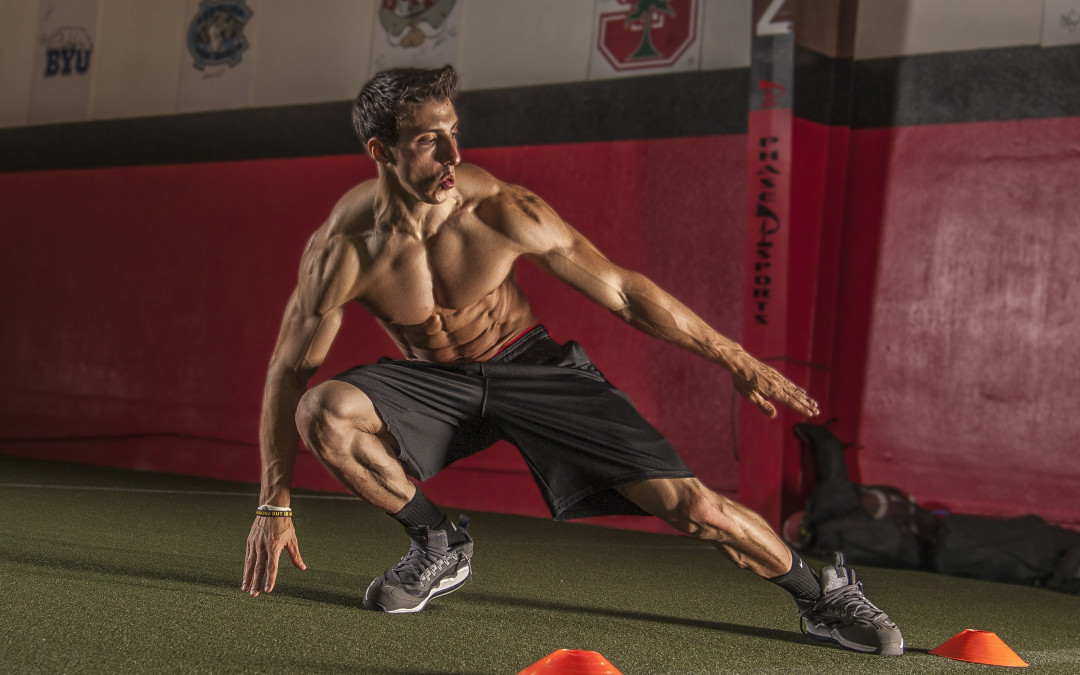Speed, agility, and quickness (SAQ) training is too often associated with sports and other physically demanding activities. Upon closer observation, we realize we have missed the everyday events and activities that can greatly benefit from SAQ training. You never know when you’re going to run after your kids, play a pick up game of basketball, or cut through the trees during your next ski trip. This method of training can help with the previously mentioned scenarios, but will also enhance workouts for anyone who is involved in recreational sports, exercises on a regular basis, or simply enjoys activities such as walking a dog or playing with their child.
As fitness professionals, we see so many people that come to the health club or gym to run on treadmills, climb on elliptical machines, or pedal away on bikes almost every day. Traditional modes of cardiorespiratory work lend to repetitive motions with little, if any, emphasis towards the frontal or transverse planes of motion. In order to cater to the body’s need for stability in all planes of motion, the fitness professional should integrate movements at varying speeds and body positions into their client’s training plan. This can be made possible with SAQ training, in addition to adjusting exercise selection and techniques.
Speed is defined as the ability to move the body in one direction as fast as possible. Agility is the ability to accelerate, decelerate, stabilize, and quickly change directions with proper posture. Quickness is the ability to react and change body position with a maximum rate of force production (1). All three components will enhance the client workout experience, satisfy the need for cardio-respiratory work, and provide variety in movement direction and position.
Before a new workout is started or modified, the participant needs to go through an assessment process. A kinetic chain assessment (KCA), goal assessment, and PAR-Q are great when they can be used together; however, the KCA will play a big role in program design. This is an opportunity to identify and qualify any recommendations for all components of the clients’ training program. These components include, and are not limited to, warm-up and flexibility, core, balance, reactive, SAQ, strength, and cool down.
The assessment process will not only address the fitness goals but will also give grounds for a corrective exercise strategy for novice and experienced exercisers alike. This client-specific strategy will complement the warm-up and the cool down needs of all workouts, not just those sessions with SAQ. Both the information provided and movements recommended should coincide in providing performance enhancement results as well as support injury prevention measures.
A gradual and structured progression is highly recommended for a client that has not incorporated a regimen for speed, agility or quickness. The following SAQ moves can be implemented 2-3 times/week into an existing workout or as a stand-alone workout with a warm-up and cool down.

A change of workout regimen will break up the monotony of the typical cardio routine. SAQ training, when implemented after a KCA, will complement the assessment results and more importantly, prepare the client for activities that they participate in, both occasionally and on a regular basis.
SAQ Exercise How-to Details
Wall Drill – 3 Count: Extend arms out against a wall at shoulder height, standing far enough away and at an angle in order to bring knee up, thigh parallel to the ground, foot dorsiflexed. Alternate legs quickly for three counts and pause. Repeat.
Arm Action: Pump/Swing arms quickly like when running. Variations include: seated with legs straight in front, kneeling (1/2 or tall), staggered stance, even stance, single leg.
Lean, Fall, Jog: Lean forward until the center of gravity is lost. Then sprint at full speed for 20 yards, maintaining the forward lean. (AKA: Falling Starts)
L.E.F.T. Drill: Place two cones 10 yards apart. Starting at first cone, sprint forward to other cone. Backpedal back to start. Side shuffle to opposite cone, side shuffle back to start with opposite leg leading. Carioca to second cone, carioca back with opposite leg leading. Sprint one final time to end cone. Rest. Repeat.
Figure 8: Place two cones 5 yards apart. Start with cone on either right or left side of athlete facing other cone. Run to opposite side of other cone therefore passing cone on other side of your body. For example, if you start with the cone on your right, as you sprint to the other cone, it will now be on your left. Round the cone as fast as you can, as close as you can until you are in line to sprint back to the starting cone. Repeat the rounding of the cone, which will take you through a figure eight running pattern around the two cones. Rest. Repeat.
M Drill: Using 5 cones approximately 10 yards apart with 4 cones on the corners and 1 cone in the middle. Imagine drawing an “M” with the cones with the middle point of the “M” as the middle cone. Run forward 10 yards to opposite cone, back pedal to middle cone, sprint from middle cone to far corner cone, back pedal straight backward to final cone. Rest. Repeat, starting from right and left sides.
References:
1. Clark, M.A., Sutton, B.G., Lucett, S.C. (2014). NASM Essentials of Personal Fitness Training, 4th Edition, Revised. Burlington, MA: Jones and Bartlett Learning.
(For another SAQ Workout- checkout Get Fast! You can also find more information on SAQ training in the NASM Certified Personal Trainer certification materials as well as the NASM Performance Enhancement Specialization materials.)

